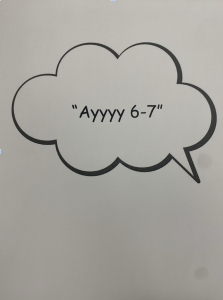Should DCIS Revive After-School Sports Teams?
Could Day Creek be as recognized in sports as they are in academics?
January 24, 2020
Crowds of parents and fans gather at Day Creek Intermediate School. They wait eagerly for their children to enter the gym, and when they do, the crowd roars with excitement. Let the games begin! There’s only one problem with this scenario: our school doesn’t even have any competitive sports teams.
In 2007, Mrs. Sprague, now the Assistant Superintendent of Instruction and Pupil Services, was the principal at Day Creek Intermediate School. At that time, DCIS had football, volleyball, basketball, soccer and track teams.
“Our district had been participating in the Highland Athletic League (HAL) for about 15 years, where all four Etiwanda intermediate schools, Ruth Musser Middle, Alta Loma Jr. High and Vineyard Jr. High participated in local competitive games,” said Mrs. Sprague.
In the 2009-10 school year, a major budget cut was issued due to “reduced funding decisions by the governor’s office,” Mrs. Sprague said. The Etiwanda School District had to reconsider what they spent their money on and “determine ways to reduce costs.”
The Highland Athletic League was costly for all schools to participate in. Each campus had to pay for uniforms ($25- $220 per person), awards for players ($10-$35 per person), transportation costs ($14.73 per hour per bus), league fees, as well as referee and coaching salaries. All of that for a limited number of participants.
The majority of the district leadership and principals agreed that it would be better to cut sports teams and add programs that were more inclusive and less expensive.
“Intramural sports meet that requirement: no limits on the number of students participating and limited costs to operate,” Mrs. Sprague said.
Currently “the budget is in better condition under the new funding formula for districts and schools – the Local Control Funding Formula.” However, schools in California with a higher percentage of poverty or English Learner students receive additional funding for more programs for students. The Etiwanda School District has a low percentage of poverty and English Learner students, so they did not receive the supplementary money.
“So while the funding has improved, we are still the lowest funded district in San Bernardino county. Which means money is still an issue,” Mrs. Sprague said.
There are multiple reasons that Day Creek doesn’t have sports teams, but aside from money, time is a significant problem.
Many students don’t know what it’s like to coach a sports team – the amount of time coaching requires and the dedication that’s needed. P.E. teachers would presumably need to work from 7:30 am to 6 pm, coaching school sports teams in addition to their required PE jobs. Shouldn’t there be room in their personal schedule for other things? Would you give up that family time for something that may not be necessary?
DCIS principal Mr. Apodaca said, “People have to make that decision. Do I stay after school a little bit longer and coach, or do I go home and spend time with my family? (Eventually) you’ve got to shut it off. At some point, I tell myself, no more emails, close the laptop. I’ve got to do my life, be a dad, be a husband. It makes sense that some of the (P.E. teachers) would say that.”
P.E teachers agree that time once devoted to after school sports has now transitioned to allow a more productive and enjoyable personal lifestyle.
“Since we’ve canceled sports at our school, it’s easier for me to stay fit and do a better job at my job because I have more time to work out. Then I can jump in and run against the kids if they need the extra motivation,” said one teacher.
Another teacher added, “Instead of going home at 3 o’clock, I would go home at 5:30 (when we did sports), and now I enjoy my life and my family (with that time).”
The P.E. teachers’ take is understandable. But is it reasonable?
P.E. teachers are among the most qualified people to coach an after school sports team because it’s likely that they have been trained to work with students in improving individual fitness. Sure, everyone needs some time to spend with their family and keep up their health. But practices and games don’t happen every day and only take place during specific seasons. There is still personal time available during weekends and some weeknights.
A third P.E. teacher shared a unique solution that may allow more students to participate.
“What I would like is to have an A and B team. A is the one that’s very competitive – people that are already playing on sports teams. The B players are the ones that aren’t necessarily in a league, but they want to have that junior high experience. So I’d want two different levels so that more kids could get a chance to play,” the teacher said.
When this idea was proposed to Mr. Apodaca, he said, “In that case what you’re looking at is just a financial piece. I like the idea, and it is something we are trying to do. But, again, (we have to ask) if that is a possibility, where we are actually playing other schools. It all goes back to the financial piece.”
The Howl created a poll on our website and Instagram asking students how they felt about sports teams. After two days, 88% of the voters on the website and 91% of the students on Instagram wanted the teams. Only 13% of the students on the website and 9% on Instagram preferred things to stay how they are.
Students had differing opinions on the topic. One student said that middle school experiences would encourage kids to try out for high school sports.
“I think we should (have sports teams) because then students can prepare for high school sports teams, so they have a preview,” said 8th grader Gitali J.
According to the International Journal of Academic Research in Business and Social Science, students who participate in sports also have better grades. Students are typically required to maintain a certain GPA to stay on a team. This raises the importance of academics as a whole, encouraging kids to try harder in class. It also promotes better time management skills in an effort to balance homework and after school activities.
While the majority of DCIS students would prefer to bring back sports, some drawbacks need an honest debate. One concern is student safety. According to the Stanford Children’s Health Center, “Approximately 3.5 million children and adolescents ages 14 and younger get hurt annually playing sports.”
Sports also take away from time previously used to complete homework, causing students to stay up late to finish assignments. This can affect much-needed sleep. According to the American Academy of Pediatrics, “children 6 to 12 years of age should sleep 9 to 12 hours. Teenagers 13 to 18 years of age should sleep 8 to 10 hours.”
Finally, as Mrs. Sprague previously indicated, money is a final hurdle.
“If I’m answering as a dad or a sports fan, (I would want the teams),” said Mr. Apodaca. “But when I answer more as a principal, and I look at the whole management of it…sure (I want the teams), but tell me where that money is going to come from. Because if I say yes to (sports teams), I have to say no to something else in order to fund that. I’d rather spend that money doing other things. You look at the cost-benefit, and maybe it is not the best use of money.”
For now, the topic is at a standstill. Maybe the students at DCIS will enjoy intramurals. Or perhaps, in the future, when money isn’t as big of a concern, the students here at Day Creek will win over the district and compete with our nearby campuses once again.







